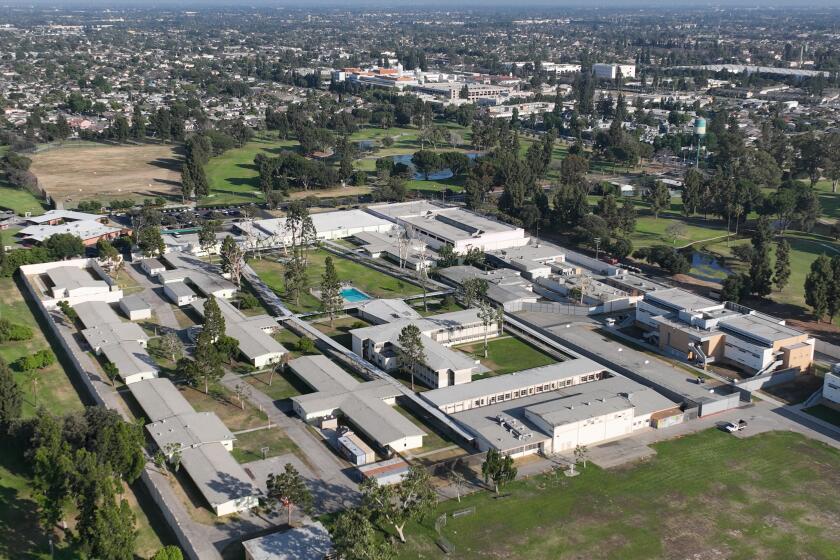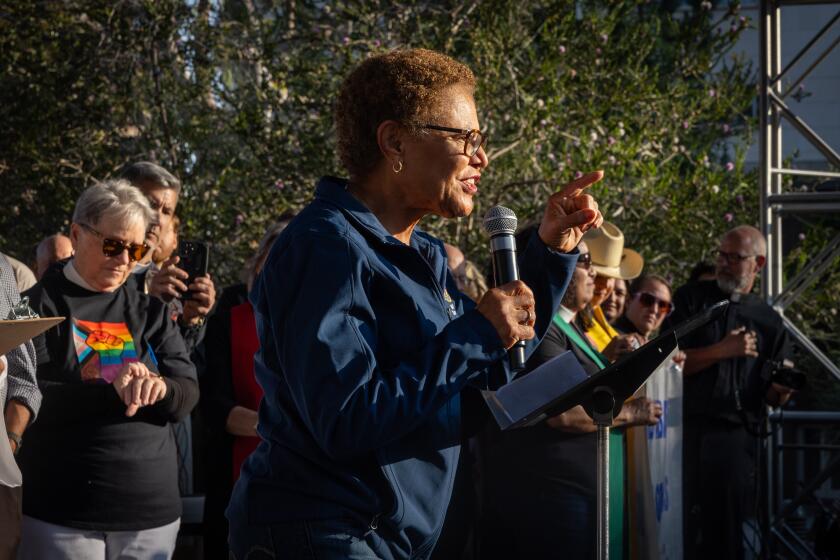Homes helped fight fire
- Share via
As black smoke plumes rose from the hills below his Anaheim Hills estate Monday, Dave Blunk stood near the fire-scorched putting green in his yard and described how his house withstood the 20-foot flames.
When he built on the hillside three years ago, “I told the architect to anticipate a fire burning right up to my house,” said Blunk, 46, who installed a water line big enough for a fire hose and built the home with concrete and steel.
On Sunday morning, the Windy Ridge fire, sparked by an arsonist and fanned by gusts, quickly chewed through more than 2,000 acres near Anaheim Hills’ multimillion-dollar homes.
Though it crackled into and over Blunk’s estate in the gated Pointe Premier community, the only remnants of the fire were scorched plants, the burned putting green and ashes in his pool.
Blunk’s brush with the Windy Ridge blaze, expected to be contained by noon today, points to a major reason Anaheim Hills emerged unscathed -- the newer neighborhoods, in such a tinderbox that local firefighters recently used the chaparral-coated hills as a case study, were built to withstand Southern California’s ferocious blazes.
The sole house damaged has a wood-shake roof -- a rarity in a place that features some of Orange County’s priciest real estate, with multi-acre lots big enough to keep horses.
“That’s what gave us a chance,” said Patrick McIntosh, Orange County Fire Authority assistant chief. “It was very, very aggressive firefighting, on the air and on the ground -- and having homes that were actually defensible.”
Near the 91 Freeway and the 241 toll road, the Windy Ridge fire began about 8 a.m. Sunday when an arsonist torched a white 2004 Honda Civic reported stolen in Riverside County, said fire officials, who are scouring toll road video for clues.
Stoked by weather that has made this one of Southern California’s driest years ever, the fire raced toward Anaheim Hills and Orange, forcing the evacuation of about 1,200 people and destroying two outbuildings.
Rising humidity overnight helped firefighters corral the blaze, which has cost at least $1.5 million to fight.
In Riverside County, comparable heat and winds fueled the Sierra fire near Lake Mathews, which seared nearly 1,000 acres after it began Sunday but has been controlled.
As Monday dawned, Anaheim Hills residents who returned after evacuations were lifted surveyed the blackened hillsides, stunned that more homes weren’t charred.
“I was worried sick last night ... this is way too close,” said Alan Ford, 32, who was checking on his home under construction on Anaheim’s eastern edge.
Other factors contributed to what fire officials were lauding as a textbook example of taming wind-stoked flames.
There was a massive response, in part by firefighters converging on Southern California as a precaution during the heat and dry winds before the blaze began. Also, the tempestuous corridor that last burned years ago was well-known to local firefighters.
Little more than a year ago, a controlled burn erupted into a blaze just across the 241 toll road that consumed 10,500 acres and forced the evacuation of more than 2,000 homes.
And last month, firefighters used the Windy Ridge area as a part of a training exercise. They pored over maps and even took a field trip to the steep hills.
“You have to prepare in your mind, and we did that in this case,” said Fire Authority Capt. Glenn Sekius, who works at Fire Station 10 in nearby Yorba Linda.
“So the guys out here, they know the terrain; they know the fuels.”
That knowledge was swiftly transmitted to the 800 firefighters tackling the blaze, some of whom had traveled from as far as Monterey -- before the fire started.
For the last few years, the state has treated Southern California’s fire season as year-round and tried to ensure that major fires don’t overtax county departments, officials said.
When blistering weather hit the region, the California Department of Forestry and Fire Protection routed crews from Northern California, where fire danger was low, to the Southland.
What particularly aided them, fire officials said, was that many of the homes in Anaheim Hills, some as large as 11,000 square feet, had fire-resistant roofs and that homeowners had cleared their properties.
“There was no vegetation hanging over roofs, nothing was stacked up against the structures, and there were a lot of tile or composite roofs,” said Maria Sabol, an Anaheim Fire Department spokeswoman.
Paved streets and manicured lawns also acted as firebreaks, which were key in an area where coastal moisture feeds chaparral growth and the bone-dry winter had sapped water from vegetation, said Richard Minnich, an earth sciences professor at UC Riverside.
He compared Anaheim Hills to Rancho Cucamonga, a San Bernardino County community of recently constructed homes that survived the 2003 Grand Prix fire. By contrast, in San Bernardino’s Del Rosa neighborhood, another wildfire that same year ravaged 20 mostly older houses.
“Everything in Southern California burns. Even our deserts burn,” Minnich said. “You can’t have a flammable exterior.”
On a street called Overlook Terrace in Anaheim Hills, developer Kang-Shen Chen, 66, had placed a Bible and the Taoist text Tao Te Ching on a rock outside his home just before he evacuated Sunday.
Upon his return, some storage units and an outbuilding had been scorched, but his home and a row of pine and pepper trees came through unscathed.
“It’s a miracle. These books protected us. God blessed us,” he said.
Nevertheless, he plans to hem in the trees with a concrete firebreak.
roy.rivenburg@latimes.com
ashley.powers@latimes.com
Times staff writers David Haldane, Dave McKibben and Maeve Reston contributed to this report.
More to Read
Sign up for Essential California
The most important California stories and recommendations in your inbox every morning.
You may occasionally receive promotional content from the Los Angeles Times.














